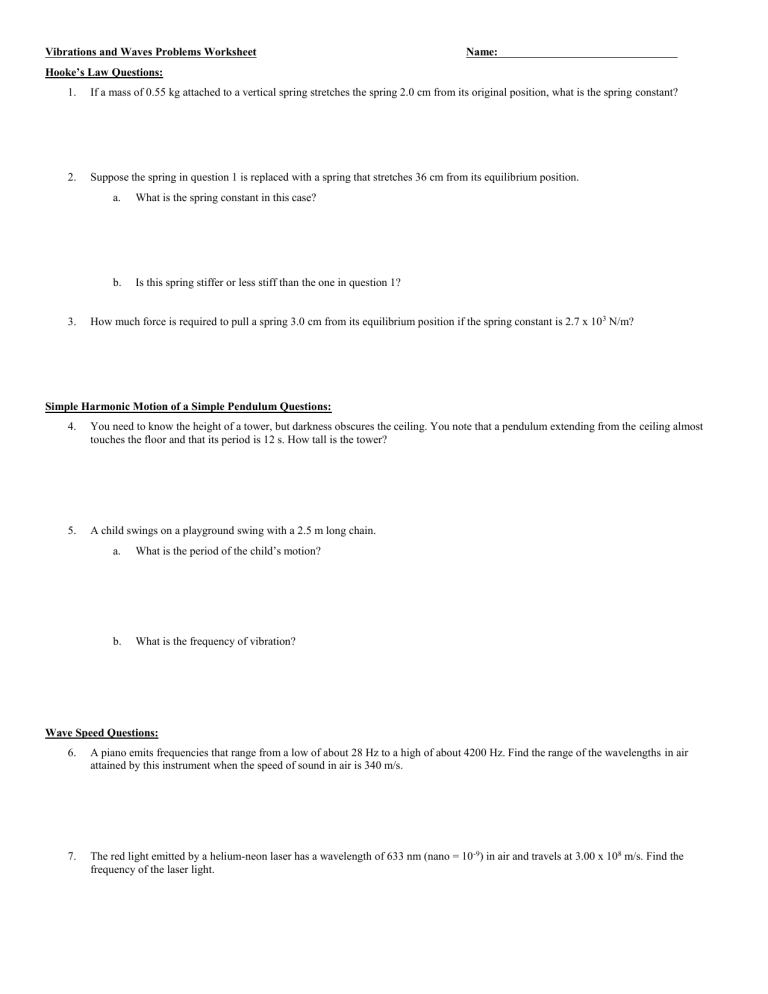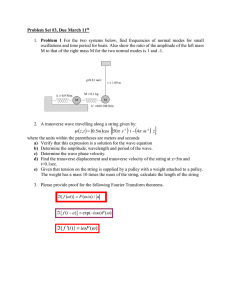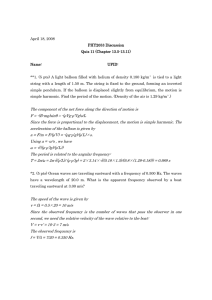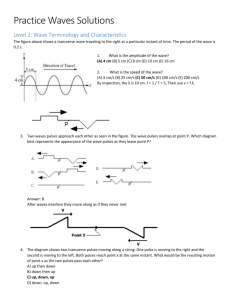Waves Problems Worksheet II

Vibrations and Waves Problems Worksheet
Hooke’s Law Questions:
Name:
1.
If a mass of 0.55 kg attached to a vertical spring stretches the spring 2.0 cm from its original position, what is the spring constant?
2.
Suppose the spring in question 1 is replaced with a spring that stretches 36 cm from its equilibrium position. a.
What is the spring constant in this case? b.
Is this spring stiffer or less stiff than the one in question 1?
3.
How much force is required to pull a spring 3.0 cm from its equilibrium position if the spring constant is 2.7 x 10 3 N/m?
Simple Harmonic Motion of a Simple Pendulum Questions:
4.
You need to know the height of a tower, but darkness obscures the ceiling. You note that a pendulum extending from the ceiling almost touches the floor and that its period is 12 s. How tall is the tower?
5.
A child swings on a playground swing with a 2.5 m long chain. a.
What is the period of the child’s motion? b.
What is the frequency of vibration?
Wave Speed Questions:
6.
A piano emits frequencies that range from a low of about 28 Hz to a high of about 4200 Hz. Find the range of the wavelengths in air attained by this instrument when the speed of sound in air is 340 m/s.
7.
The red light emitted by a helium-neon laser has a wavelength of 633 nm (nano = 10 -9 ) in air and travels at 3.00 x 10 8 m/s. Find the frequency of the laser light.
8.
A tuning fork produces a sound with a frequency of 256 Hz and a wavelength in air of 1.35 m. a.
What value does this give for the speed of sound in air? b.
What would be the wavelength of this same sound in water in which sound travels at 1500 m/s?
Wave Characteristics and Interactions Questions:
9.
As waves pass by a duck floating on a lake, the duck bobs up and down but remains essentially in one place. Explain why the duck is not carried along by wave motion.
10.
Sketch each of the following waves that are on a spring that is attached to a wall at one end: a.
a pulse wave that is longitudinal. b.
a periodic wave that is longitudinal. c.
a pulse wave that is transverse. d.
a periodic wave that is transverse.
11.
Draw a graph for the wave described in 10(d) and label the y -axis of the graph with the appropriate variable. Also, label the crest, trough, wavelength and amplitude.
12.
A wave of amplitude 0.30 m interferes with a second wave of amplitude 0.20 m. What is the largest resultant displacement that may occur?
13.
A string is rigidly attached to a post at one end. Several pulses of amplitude 0.15 m sent down the string are reflected at the post and travel back down the string without a loss of amplitude. What is the amplitude at a point on the string where the maximum displacement points of two pulses cross? What type of interference is this called?
14.
How would your answer to problem 13 change if the same pulses were sent down a string whose end if free? What type of interference is this?











